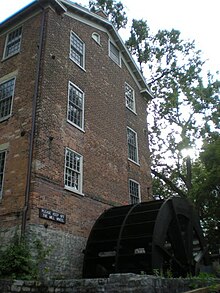Salt Creek (Des Plaines River Tributary)
| Salt Creek | |
|---|---|

Graue Mill which stands on the bank of the creek
|
|
| Basin features | |
| Main source |
Hoffman Estates, Illinois 42°05′58″N 88°06′41″W / 42.0994706°N 88.1114642°W |
| River mouth |
Confluence with the Des Plaines River, Lyons, Illinois 607 ft (185 m) 41°49′06″N 87°49′57″W / 41.8183649°N 87.8325578°WCoordinates: 41°49′06″N 87°49′57″W / 41.8183649°N 87.8325578°W |
| Progression | Salt Creek → Des Plaines → Illinois → Mississippi → Gulf of Mexico |
| Physical characteristics | |
| Length | 43 mi (69 km) |
| GNIS ID | 422069 |
Salt Creek is a 43.4-mile-long (69.8 km) stream in northeastern Illinois. It is an important tributary of the Des Plaines River, part of the Illinois River and ultimately the Mississippi River watersheds. It rises in northwest Cook County at Wilke Marsh in Palatine and flows in a meandering course generally southward through DuPage County, returning to central Cook County and emptying into the Des Plaines River in Riverside, Illinois. Most of the creek's watershed is urbanized, densely populated and flood-prone.
Flood control dams were constructed along the creek in 1978 within the Ned Brown Forest Preserve near Elk Grove Village, Illinois, creating the 590-acre (2.4 km2) Busse Lake. A diversion tunnel was constructed approximately 1.6 miles (2.6 km) north of the confluence with the Des Plaines River, at a point where the two streams are separated by only 1,600 feet (490 m).
Tributary streams include Addison Creek. The Graue Mill historic gristmill stands on the bank of the creek in Oak Brook.
It was originally known to European settlers as the Little Des Plaines River but was given the name Salt Creek in the mid-nineteenth century after a large wagonload of salt spilled in the waterway. Some of the species of fish in the creek include carp, smallmouth bass, northern pike, bluegill/sunfish minnow/shad, and bullhead catfish.
...
Wikipedia
